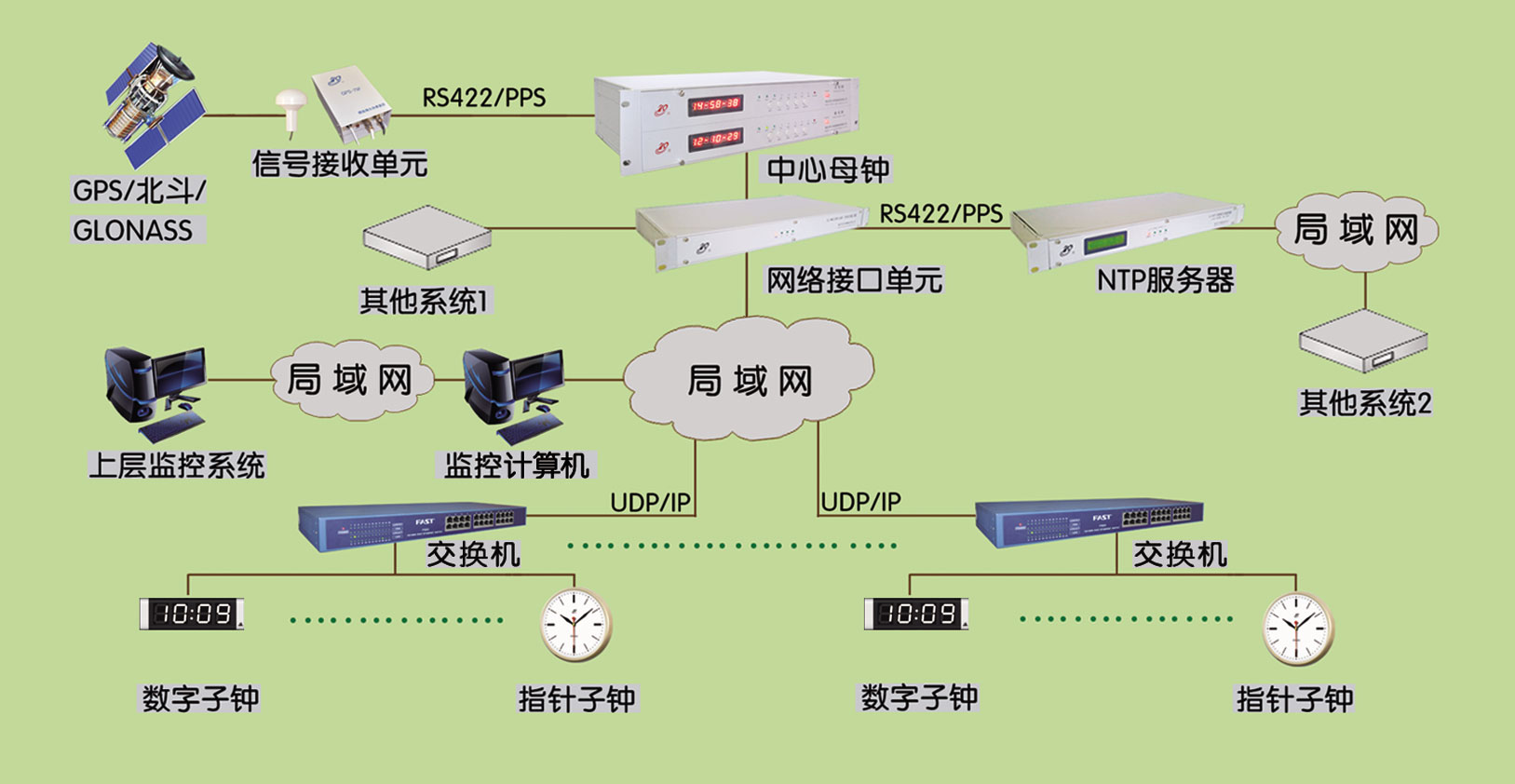Sports Venue Time System Solution

Basic Features
The central master clock receives the standard time signal from GPS/Beidou/GLONASS, transmits it to the slave clock through the network interface unit, and provides it to other users by the NTP server and network interface unit to realize the time synchronization of the whole system. At the same time, the state monitoring of the whole system is realized through the monitoring computer, and the state information can be provided to the upper-level monitoring system.
Key Features
In order to adapt to the rapid development of communication technology in the network era, the system adopts the world's most advanced network time synchronization technology, and realizes network time synchronization by innovating key technologies such as network time synchronization, network load balancing, multiple redundant backup, network fault diagnosis and automatic alarm. High precision and high reliability of synchronization. At the same time, the appearance design of the equipment and the decoration style of the site are coordinated with each other to achieve the perfect combination of function and appearance.
Technical parameters
The system adopts two-layer structure of central master clock and slave clock, and Ethernet communication mode. The system improves the accuracy, reliability and security of the regional clock synchronization system through the unique core technology groups such as PPS backward compensation, high-precision time stamp recording, output intelligent judgment, parallel undisturbed redundancy, and network time closed-loop feedback. Clock synchronization technology leads the international level. The system is mainly used in regional clock synchronization, such as intelligent buildings, railway stations, bus stations, TV stations, standard workshops, schools, hospitals, gymnasiums and other occasions.
System Parameters
| 1) System Architecture: | Two layers |
2) Communication protocol: | NTP protocol |
3) Communication distance: | equivalent to LAN |
4) Number of secondary master clocks: | equivalent to the transmission system |
5) System standard configuration: | The number of analog sub-clocks and digital sub-clocks can be ≤2000 |
| 6) System synchronization error: | Sub clock≤10ms, NTP server≤2ms |
Device parameters
| GPS/Beidou/GLONASS Signal Receiving Unit | |
| 1) Operating temperature: | -30℃~+65℃ |
2) Relative Humidity: | ≤95% |
3) Frequency stability: | 10-12~10-9 |
4) Sync Error: | GPS≤50ns, Beidou≤100ns, GLONASS≤30ns |
5) Signal transmission distance: | ≤1200m |
6) Interface: | Standard RS422/485 |
7) Antenna feeder length: | 5~100m (Standardwith 30m) |
8) Power supply: | AC220V±15% 50Hz±5% |
| 9) Power consumption: | ≤1.4W |
| 10) MTBF: | ≥85,000 hours |
| 11) Antenna: | With dustproof, waterproof, anti-corrosion, lightning protection |
| Central Master Clock | |
| 1) Self-timer precision: | ±0.001s/d |
| 2)Working humidity: | -10℃~+65℃ |
| 3)Relative Humidity: | ≤95% |
| 4) Interface: | Standard RS422/RS485/RS232/NTP |
| 5) Number of standard output ports: | 2 |
| 6) The number of sub-clocks that can be built: | ≤5000 sides |
| 7) Wait for the secondary master clock: | ≤1000 sets |
| 8)Power: | AC220V±15% 50Hz±5% |
| 9) Power consumption: | ≤20W |
| 10) MTBF: | ≥85,000 hours |
Secondary Master Clock | |
1) Self-timer precision: | ±0.01s/d |
2) Working temperature: | -10℃~+65℃ |
3) Relative Humidity: | ≤95% |
4) Interface: | Standard RS422/RS485/RS232/NTP |
5) Number of standard output ports: | 2 |
6) The number of sub-clocks that can be built: | ≤2000 faces |
7) Power: | AC220V±15% 50Hz±5% |
8) Power consumption: | ≤20W |
| 9) MTBF: | ≥85,000 hours |
Analog Clock | |
1) Self-precision: | ±0.05s/d |
2) Output torque: | 800~1200g. cm |
3) Working temperature: | -35℃~+70℃ |
4) Relative Humidity: | ≤95% |
5) Working voltage: | AC220V±15% 50Hz±5% |
| 6) MTBF: | ≥85,000 hours |
Digital Clock | |
| 1) Self-precision: | ±0.05s/d |
| 2) Output torque: | 800~1200g·cm |
| 2) Working temperature: | -35℃~+70℃ |
| 3) Relative Humidity: | ≤95% |
| 4) Working voltage: | AC220V±15% 50Hz±5% |
| 5)MTBF: | ≥85,000 hours |
| 6) Interface: | NTP |
